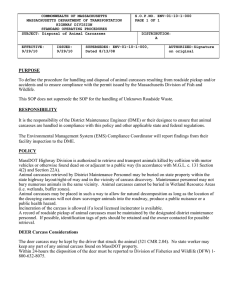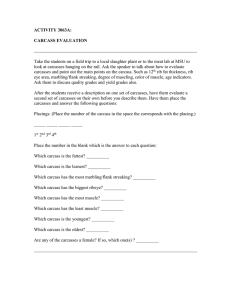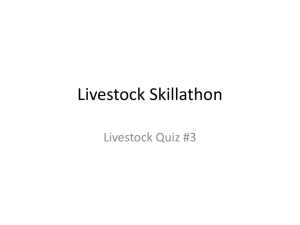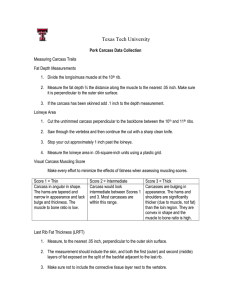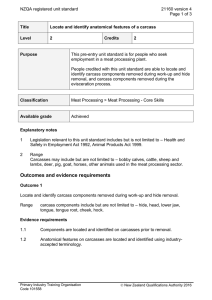Note Taking Guide Topic # 3063 Carcass Evaluation
advertisement
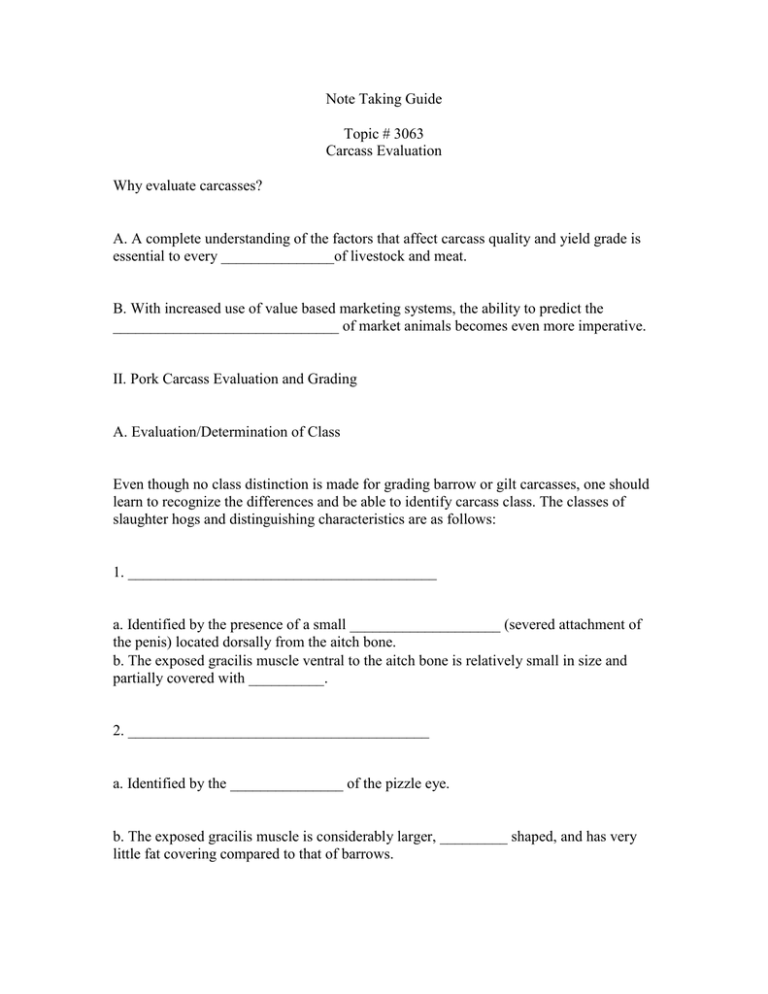
Note Taking Guide Topic # 3063 Carcass Evaluation Why evaluate carcasses? A. A complete understanding of the factors that affect carcass quality and yield grade is essential to every _______________of livestock and meat. B. With increased use of value based marketing systems, the ability to predict the ______________________________ of market animals becomes even more imperative. II. Pork Carcass Evaluation and Grading A. Evaluation/Determination of Class Even though no class distinction is made for grading barrow or gilt carcasses, one should learn to recognize the differences and be able to identify carcass class. The classes of slaughter hogs and distinguishing characteristics are as follows: 1. _________________________________________ a. Identified by the presence of a small ____________________ (severed attachment of the penis) located dorsally from the aitch bone. b. The exposed gracilis muscle ventral to the aitch bone is relatively small in size and partially covered with __________. 2. ________________________________________ a. Identified by the _______________ of the pizzle eye. b. The exposed gracilis muscle is considerably larger, _________ shaped, and has very little fat covering compared to that of barrows. c. No _______________ development. 3. ________________________________________ a. Identified as same characteristics as those for __________. b. Distinguished from gilts by their developed mammary Tissue associated with lactation or advanced stages of _______________. c. Sow carcasses are usually heavier than __________. 4. _______________________________________ a. Identified by same characteristics as those for _______________. b. The pizzle of stags and boars is __________ and more prominent than in barrows because of sexual maturity. c. The shoulders of stags and boars are heavier muscled with larger bones and joints, and the skin over the shoulders is somewhat thicker and the color of lean is darker compared to boars. d. Stags and boar carcasses are usually ____________ and more _______________ in appearance than barrows. B. Weight 1. Hot carcass weight is almost always obtained on pork carcasses just prior to ____________________. 2. Hot carcass weight is shrunk __________ to obtain chilled carcass weight. (hot carcass wt. x .985 = chilled carcass wt.) 3. If chilled carcasses are weighed, they are weighed just prior to cutting the wholesale cuts. 4. Chilled carcass weight is used to calculate dressing percentage of hogs by dividing by the live weight and multiplying by _________________. C. Length 1. Carcass ____________________ is measured with a metal tape or may be estimated on the hanging carcass from the cranial edge of the first rib adjacent to the backbone to the cranial edge of the aitch bone (pubic symphysis.) 2. Usually only one side of each carcass is measured, but both sides may be measured and then _______________. D. Backfat Thickness 1. Thickness of backfat is estimated or measured primarily at two different locations. a. The first measurement is taken at the _________________ to determine pork carcass U.S.D.A. grade. b. The second measurement is taken at the _______________ which is used to calculate percent muscle in pork carcasses. 2. Backfat measurements are generally taken with a _____________ _______________ and the measurement is made to the nearest .1 in. E. Ribbing Pork Carcasses 1. Pork carcasses are frequently ribbed at the _______________ interface to expose the loin eye muscle and backfat for educational purposes. 2. Pork carcasses are seldom ribbed (cut between the 10th and 11th rib to exposethe loin eye muscle and 10th rib backfat) in commercial practice because of devaluation of the ___________________________ and belly. 3. The pork carcass grade standards are designed for use on _______________ carcasses. F. 10th Rib Backfat Thickness 1. The depth of ____________________, including skin, is estimated or measured in tenths of inches at the 10th rib interface. 2. The 10th rib backfat is a more accurate measurement of subcutaneous fat than average backfat thickness because it is not influenced by variation in carcass _________________________. G. Loin Eye Area 1. Area of the longissimus (eye) muscle is either estimated or measured in square inches on the cross section of the muscle at the _____________________________. 2. Area is determined either with a _________________________ (most frequently used) or from a tracing of the eye muscle with a compensating polar planimeter. H. Pork Carcass Grading Grades for barrow and gilt carcasses are based on two general considerations: quality indicating characteristics of the lean and fat, and expected yield of the four lean cuts (____________________________________________________). 1. Quality a. Two levels of quality are considered: carcasses with characteristics that indicate the __________ has acceptable quality, and carcasses with unacceptable quality of lean. b. Quality of lean is usually evaluated in the eye muscle at the 10th rib interface either on ribbed carcasses or on the wholesale loin. c. Three factors are used to evaluate quality: 1) _________________________________________ 2) _______________________________________________ 3) _______________________________________________ d. Each of these factors is scored on a numerical basis from __________. 2. Yield of Lean Cuts a. Four grades, ____________________________________ are provided for carcasses that have indications of an acceptable lean quality and acceptable belly thickness. b. These grades are based entirely on the expected carcass yield of lean cuts: Grade Yield of Lean Cuts U.S. No. 1 60.4% and over U.S. No. 2 57.4% to 60.3% U.S. No. 3 54.5% to 57.3% U.S. No. 4 Less than 54.4% c. Pork carcasses differ in lean cut yield because of differences in ____________________ and in degree of _______________. d. Backfat thickness is most highly related to yield of lean cuts. As the amount of external fat increases, the yield of lean cuts _______________. e. The degree of muscling is determined by a subjective evaluation of the thickness of muscling in relation to skeletal size. _______________ must also be considered when degree of muscling is evaluated. III. Beef Carcass Evaluation and Grading The first step in beef carcass evaluation is the determination of class or sex group. Class determination of beef carcasses is based on evidences of _______________ and sex condition at the time of slaughter. In addition to class, the bovine specie is subdivided into __________. A. Determination of Kind The differentiation between veal, calf, and beef carcasses is made primarily on the basis of the ____________________, although such factors as texture of lean, character of the fat; color, size, and ossification of the bone and cartilages, and the general contour of the carcass are also given consideration. 1. Veal a. Veal carcasses have a grayish pink to dark grayish pink color of lean that is smooth and velvety in __________________. b. They also have a slightly soft, pliable character of fat, and narrow and very red _______________. 2. Calf a. Calf carcasses have a grayish red to moderately red color of __________, a flakier type of fat, and somewhat wider ribs with less pronounced evidences of _______________. 3. Beef a. Beef carcasses have evidences of more advanced _______________. b. Color of lean is moderately red in young beef carcasses and may be very dark red in mature beef carcasses. c. _________ is flaky and ribs show evidence of flatness and are slightly red in color in young beef carcasses. d. _______________ shows some evidence of ossification in the sacral and lumbar regions compared to calf carcasses. B. Determination of Class Since the ____________________ standards and some of the qualitative properties (i.e, color, texture, etc.) of beef carcasses vary by class, identification of class is necessary in carcass evaluation. The following characteristics are used to identify and categorize beef carcasses into their respective classes. 1. ____________________ a. Identified by the typically rough and irregular shaped fat deposit in the cod region and the presence of a relatively small ____________________ (white disc caudal to the aitch bone; it is the severed proximal portion of the penis). 2. ____________________ a. Identified by their disproportionately heavy development of _______________, noticeable crests, thickly fleshed chucks, and large prominent pizzle eyes. b. Bullock carcasses usually have a noticeably developed small, round muscle adjacent to the hip bone commonly referred to as the _________________________. (May be covered with fat.) c. _______________ fat is typically rough and irregular in shape like that of steers and bulls. The appearance of this fat deposit of steers, bullocks, and bulls contrasts the smooth fat deposit of the udder in _______________. d. The lean of bullocks is usually darker and coarser in _______________ than that of steers, but usually it is not as dark or as coarse as that from _______________. e. The distinction between bullock and bull carcasses is based solely on their evidences of _______________ (bone and cartilage) maturity with bullocks being the younger of these two classes. 3. ____________________ a. Identified by their disproportionately heavy development of rounds, noticeable crests, thickly fleshed chucks, and large prominent ____________________. b. Noticeably developed ____________________. (May be covered with fat.) c. ________________ fat is typically rough and irregular in shape like the fat found in steers and bullocks, which contrasts the smooth_______________ fat of heifers. d. The lean is usually dark__________ and coarse textured. e. The bone characteristics of bulls show evidence of advancing skeletal _______________. 4. ____________________ a. Identified by smooth, uniform fat deposit in the __________ region, the absence of the pizzle eye, a slightly larger pelvic cavity, and a straighter aitch bone than steers. b. Heifer carcasses have a large, _______________ bald spot (gracilis muscle) because the muscle has less fat covering it than steers. c. _______________ heavily muscled. 5. ____________________ a. Identified by their relatively large pelvic cavity and nearly straight _______________ bone (accommodates calving.) b. _______________ is usually removed. c. Hips of cow carcasses usually range from slightly prominent to very prominent. d. Most cows are old when marketed, and in such carcasses the sacral vertebrae are fused and appear as essentially one bone. e. All bones are usually __________, white, and the cartilage associated with the vertebrae and aitch bone are completely ossified, except for the buttons which may not be completely ossified. C. Weight 1. Hot carcass weight is almost always obtained on beef carcasses just before _______________, and chilled carcass weight is usually calculated from hot carcass weight. 2. Hot carcass weight is_______________ higher than chilled carcass weight. 3. Chilled carcass weight = Hot carcass weight x __________ D. Dressing Percentage 1. Chilled carcass weight is divided by__________ weight and multiplied by 100 to obtain dressing percentage. E. Ribbing 1. Ribbing is the process of cutting one or both sides of the carcass between the _______________ rib to expose the ribeye (longissimus) muscle, _______________, and fat thickness. 2. Beef carcasses must be ribbed before they can be ____________. F. Beef Quality Grading 1. Beef carcass quality grade is based upon two major factors: (1) degree of ______________ and (2) degree of ______________. 2. In addition to these factors, __________, _______________, and firmness of ____________ in the ribeye muscle are considered in determining final quality grade. 3. The beef quality grades are USDA _______________, _______________, _______________, Standard, Commercial, Utility, Cutter, and Canner. 4. Marbling a. Marbling is the intermingling or dispersion of fat within the lean (intramuscular fat). b. Marbling is estimated on the lean cut surface of the _______________ muscle at the 12th rib interface. c. The grade standards specify more marbling for the high grades (USDA Prime and Choice) than in the lower grades (USDA Select and Standard). d. Amount of marbling in the eye muscle is divided into ten degrees: 1. __________________________ 2. _________________________ 3. _________________________ 4. _________________________ 5. _________________________ 6 . __________________________ 7. ___________________________ 8. ___________________________ 9. ___________________________ 10. __________________________ e. Marbling is an indicator of _____________________, however, as it increases caloric content also increases. f. Marbling is associated with length of ________________ _______________, type of feed, and genetic capacity for laying down this fat deposit. 5. Maturity a. Eating quality characteristics (tenderness, juiciness, and flavor) are related to animal __________. b. Maturity refers to the ____________________ age of cattle rather than to the chronological age (usually unknown). c. Physiological indicators of maturity include____________ characteristics, ossification of cartilage, and color and texture of the_______________ muscle. d. Cartilage ossifies (becomes bone) and bone ____________ (becomes harder, flintylike and white) with increasing age. e. Color of lean becomes darker due to accumulation of myoglobin and texture becomes coarser with age. f. There are five maturity groups and they are designated by the letters _______________. 1. _________________ maturities are from young cattle and carcasses from mature cattle are designated _______________. 2. Because of ossification that has occurred in the bones and cartilage, these C, D, and E maturity carcasses are called "_____________________." G. Beef Yield Grading 1. Yield grade is a numerical value form 1 to 5 based upon the yield of _______________ closely trimmed (approximately .3 in.), retail cuts from the ______________________________ _________________________________________ . 2. These four whole sale cuts make up about __________ of the weight, but about 90% of carcass _______________. 3. The following factors have the greatest influence on carcass ______________________: a. fat thickness at 12th rib b. ribeye area (measured with grid) c. hot carcass weight d. percentage kidney, pelvic, and heart fat (KPH) IV. Lamb Carcass Evaluation and Grading Before beginning to evaluate lamb carcasses, the carcasses must be identified as to their sex condition or _______________ and their maturity group or ____________. It is necessary to identify kind and class of sheep carcasses prior to grading so that one can apply the correct set of standards and grades because they differ slightly among classes and especially among the different kinds. A. Determination of Kind 1. ____________________ a. Approximately __________ months of age. b. Have the characteristic "_______________" on at least one of their front shanks. c. Flank muscles on the inside of the carcass vary in color from slightly dark pink to slightly dark red. d. The ribs vary from quite round in shape to moderately flat and show_______________ on their surface. 2. ______________________________ a. Approximately __________ months of age. b. Have "_______________" on both front shanks, or one spool joint and one imperfect break joint, or imperfect break joints on both front shanks. c. Color of the flank muscles on the inside of the carcass varies from slightly dark red to moderately dark red. d. __________ are moderately wide and tend to be flat, and they range from slight redness to no redness on their exposed surface. 3. _____________________________ a. Older than __________ months of age. b. Always have _______________ joints. c. Color of the flank muscles on the inside of the carcass varies from dark red to very dark red. d. Ribs are wide, flat, and the color of ____________ bone. 4. Break joints a. The break joint is the epiphyseal cartilaginous area of the cannon bone which is not _______________ in young sheep. It breaks easily in this location when pressure is applied. b. In _______________ sheep the epiphyseal area ossifies and fuses to the diaphysis of the metacarpal and cannot be broken. c. A perfect break joint has all the ridges of the__________ intact and is well defined. d. In an imperfect break joint, a portion of the ridges may be _______________ or damaged because of an imperfect break. B. Determination of Class 1. _______________ a. Identified by the presence of the _______________. b. In muttons, the udder may be wet and removed at the time of slaughter. c. In lambs and yearlings, the udder is present and it is a relatively long, smooth __________ deposit. 2. _______________ a. Identified by the presence of _______________. b. In contrast to the udder, cod fat is rough, irregular shaped and usually is a much ______________ deposit of fat than the udder. 3. _______________ a. __________ fat in the scrotal area than either wethers or ewes. b. Fat is irregularly shaped, like a _______________. c. __________, heavy shoulders and thick necks. C. Weight 1. Hot carcass weight is almost always obtained on lamb carcasses just prior to _______________. 2. _______________ weight is calculated from hot carcass weight. 3. Hot carcass weight is shrunk__________ to obtain chilled carcass weight. 4. Hot carcass weight x __________ = chilled carcass weight. D. Dressing Percentage 1. Chilled carcass weight is dived by live weight and multiplied by 100 to obtain ______________________________. E. Ribbing Lamb Carcasses 1. Lamb carcasses are ribbed between the 12th and 13th rib to expose the _______________ muscle and actual__________ thickness. 2. Lamb carcasses should be ____________ graded prior to ribbing. 3. Lamb carcasses are __________ graded after the carcass is ribbed. F. Ribeye Area 1. The area on both the right and left eye muscle is _____________ because they sometimes differ in area. (Usually do not differ by more than .1 or .2 square inches.) 2. The right and left areas are _______________ to obtain ribeye area for each carcass. 3. Area may be measured directly on the carcass with a grid or from a tracing of the right and left eye muscle by a compensating planimeter. G. Quality Grade 1. Based upon a composite evaluation of _______________, _______________, and quality of lean flesh. 2. Quality of lean flesh is evaluated by the quantity of fat streakings on the inside __________ muscles, firmness of the lean flesh, and external fat. 3. The quality grades of lamb carcasses are: USDA __________, __________, __________, and __________. 4. Conformation is an assessment of overall muscling in the lamb carcass with emphasis on the greatest development of muscling in the highest priced primal cuts which range in order of value from the __________, __________, _______________, and _______________. 5. _______________ is an assessment of physiological age of the animal. a. Lambs are characterized as either __________ maturity by the federal meat grading standards. b. Maturity is determined by an assessment of __________ and _______________ characteristics. 1. Bones include the break joint(s) and the shape of __________. 2. The ridged surface of the break joint(s) is quite red, moist, and ____________ in A maturity and becomes progressively less red, drier, and harder with advancing maturity in the B group. 3. Muscle characteristics include an evaluation of the color of the inside ____________ muscles. H. Yield Grade 1. Yield grade is based on the amount of _______________ fat present. 2. Yield refers to the estimated percent of closely trimmed, _______________ or semiboneless retail cuts from the leg, loin, rack and shoulder. 3. These four wholesale cuts represent __________ of the carcass weight and approximately 90% of carcass value. 4. As the amount of external fat increases, the percent of retail cuts _______________. a. Each .05 inch change in adjusted fat thickness over the ribeye muscle between the 12th and 13th ribs changes the yield grade by __________ a grade. 5. Five yield grades are denoted by numbers 1 through 5 a. 1 represents the highest degree of ___________.
